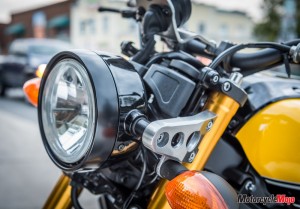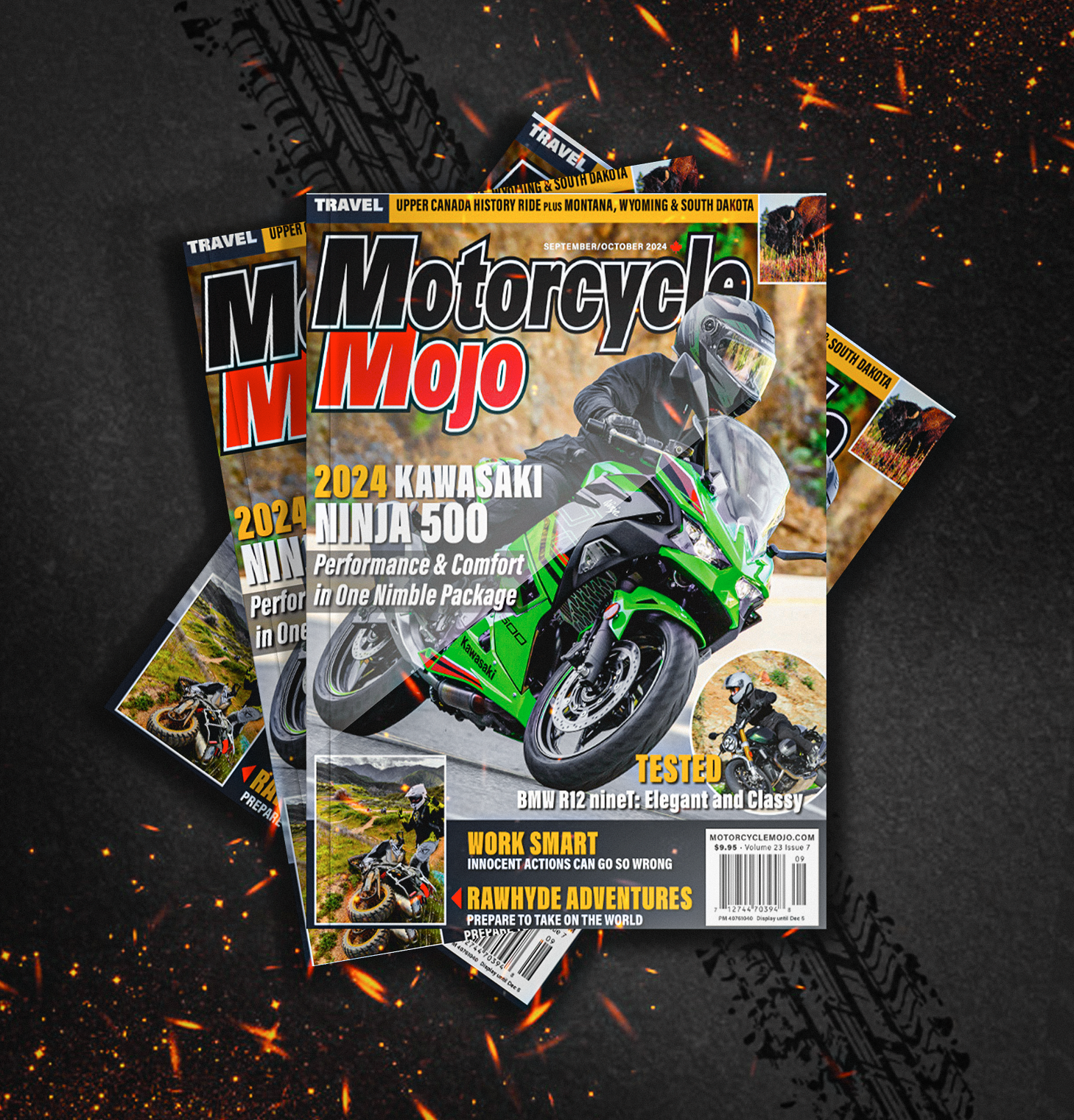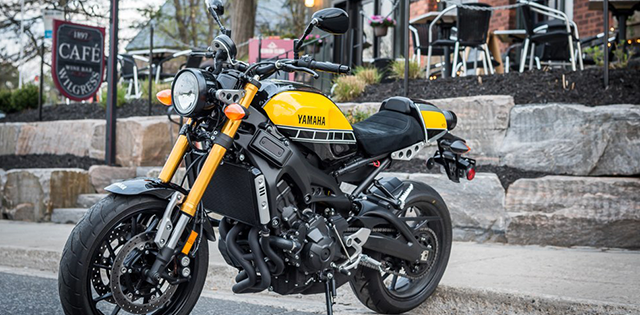The Best of Both Worlds
Sandwiched between the virtues of a twin and four-cylinder, this modern throwback to Yamaha’s classic XS series of motorcycles should appeal to a wide range of riders
Inline-triples were never as numerous or as popular as they are today. MV Agusta and Triumph have offered a variety of motorcycles featuring this unique engine layout for several years now. The engine combines the strong low-end torque of a twin with the free-revving nature of an inline-four, and, of course, it emits a distinctive and very appealing exhaust note. Yamaha remains the only Japanese manufacturer to have ever produced a four-stroke inline-triple, and older riders whose memory is still intact will remember the XS750/850 of more than three decades ago.
 The tuning-fork company reintroduced a triple into its lineup only recently, when it launched the FZ-09 in 2014. This year, Yamaha follows up on that bike with a spinoff model that puts a twist on the retro movement we’ve been enjoying lately. The all-new XSR900 is built on the FZ-09 platform, but features some classic styling cues. Although it shares the FZ’s chassis and engine, there’s a bit more to the XSR than just a fresh set of retro-look bodywork. Yamaha Canada held a press intro for the XSR900 (as well as the all-new FZ-10, which you’ll read about in a future issue) in Ontario’s picturesque Muskoka region, where there are plenty of lakes, cottages and winding roads to explore.
The tuning-fork company reintroduced a triple into its lineup only recently, when it launched the FZ-09 in 2014. This year, Yamaha follows up on that bike with a spinoff model that puts a twist on the retro movement we’ve been enjoying lately. The all-new XSR900 is built on the FZ-09 platform, but features some classic styling cues. Although it shares the FZ’s chassis and engine, there’s a bit more to the XSR than just a fresh set of retro-look bodywork. Yamaha Canada held a press intro for the XSR900 (as well as the all-new FZ-10, which you’ll read about in a future issue) in Ontario’s picturesque Muskoka region, where there are plenty of lakes, cottages and winding roads to explore.
As mentioned, the XSR900 shares chassis components with the FZ-09; it uses the same CF die-cast aluminum frame and swingarm, and the same preload- and rebound-adjustable 41 mm inverted fork and single shock. Steering geometry is unchanged with the rake at 25 degrees, trail at 103 mm and wheelbase at 1,440 mm. Where the XSR surpasses the FZ-09 is in the braking department. Although it sports the same 298 mm front discs with radial four-piston calipers, and a 245 mm rear disc and single-piston caliper, the XSR comes standard with ABS, a feature that isn’t available on the FZ.
First Impression
 Hopping onto the XSR900, the first noticeable difference compared to the FZ-09 is that the seat is wider and more supportive, and at 830 mm from the ground, it’s a touch taller (15 mm taller). This added seat height allows for a more relaxed distance from the seat to foot pegs, while still allowing for a relatively easy reach to the ground. The front of the bike almost disappears from your view when seated, though when you do look down, you’ll see a new round digital gauge, as opposed to the trapezoidal unit on the FZ-09. I’d have preferred an analogue gauge, mostly to remain faithful to the XSR retro styling, but it does provide lots of information, including time, gear position, fuel consumption and air temperature, aside from the basics like speed and engine revs.
Hopping onto the XSR900, the first noticeable difference compared to the FZ-09 is that the seat is wider and more supportive, and at 830 mm from the ground, it’s a touch taller (15 mm taller). This added seat height allows for a more relaxed distance from the seat to foot pegs, while still allowing for a relatively easy reach to the ground. The front of the bike almost disappears from your view when seated, though when you do look down, you’ll see a new round digital gauge, as opposed to the trapezoidal unit on the FZ-09. I’d have preferred an analogue gauge, mostly to remain faithful to the XSR retro styling, but it does provide lots of information, including time, gear position, fuel consumption and air temperature, aside from the basics like speed and engine revs.
 The XSR still uses a 12-valve, 849 cc inline-triple that claims 113 hp and 64 ft-lb of peak torque. The compression ratio is 11.5:1, so you need not gas up with pricey premium fuel, and valve adjustment intervals are set at a very agreeable 42,000 km. Mikuni provides the 41 mm throttle bodies, which are part of the closed-loop EFI, which is controlled by Yamaha’s YCC-T ride-by-wire system. It also has three ride modes, or what Yamaha calls D-modes. The standard setting provides a slightly softer throttle response than the more aggressive A mode, with B mode being the softest setting, meant for riding in rain or other traction-inhibiting conditions. I found that B mode works best in tight quarters, and it would probably be my chosen mode when negotiating city traffic. But on this ride, my default setting is A mode, which provides a very responsive throttle, allowing for adrenaline-pumping acceleration on the short straight bits between turns, regardless of which gear the bike is in. And make no mistake, the inline-triple is very strong from the bottom up, pulling in a very linear yet energetic fashion as the tachometer bar climbs up the scale. Despite needing little reason to work the shifter often, the transmission is light with short, positive lever throws.
The XSR still uses a 12-valve, 849 cc inline-triple that claims 113 hp and 64 ft-lb of peak torque. The compression ratio is 11.5:1, so you need not gas up with pricey premium fuel, and valve adjustment intervals are set at a very agreeable 42,000 km. Mikuni provides the 41 mm throttle bodies, which are part of the closed-loop EFI, which is controlled by Yamaha’s YCC-T ride-by-wire system. It also has three ride modes, or what Yamaha calls D-modes. The standard setting provides a slightly softer throttle response than the more aggressive A mode, with B mode being the softest setting, meant for riding in rain or other traction-inhibiting conditions. I found that B mode works best in tight quarters, and it would probably be my chosen mode when negotiating city traffic. But on this ride, my default setting is A mode, which provides a very responsive throttle, allowing for adrenaline-pumping acceleration on the short straight bits between turns, regardless of which gear the bike is in. And make no mistake, the inline-triple is very strong from the bottom up, pulling in a very linear yet energetic fashion as the tachometer bar climbs up the scale. Despite needing little reason to work the shifter often, the transmission is light with short, positive lever throws.
Distinctive Additions
Where Yamaha has distinguished the XSR’s engine from the FZ’s, which also in part justifies the XSR’s higher price (it starts at $10,699, versus $8,999 for the FZ), is with the addition of a slipper clutch and adjustable traction control. The mechanically assisted clutch has a 20 percent lighter pull than that of the FZ, and the traction control has two levels of intervention, or it can be shut off.
Being heavily based on the FZ-09, it’s no surprise that the XSR rides very much like its techno-styled naked brother. The bike is very flickable, easily threading its way through tight turning transitions, and it exhibits very good straight-line stability, though as on the FZ, the wide handlebar does introduce a bit of rider-induced twitchiness if you hold on too tightly. It feels light and nimble at low speeds, which is expected considering Yamaha claims that it weighs just 195 kg wet. This is 7 kg heavier than the FZ-09, despite both bikes carrying 14 litres of fuel with a full tank. The added weight can likely be attributed to the different bodywork and the added electronics controlling things like traction control and ABS.
The Ride
The suspension proves a bit firm over a quick succession of sharp bumps, and a check of the front damping setting reveals it is set in the middle of its adjustment range. Softening the front damping (via a flat-blade screwdriver) improves the fork’s compliance. Had our ride been longer, I would have probably softened the rear damping a bit also, though I left it as is to handle our slightly spirited pace.
Pricier than the FZ-09, it also costs a few hundred dollars more than the Triumph Street Triple, which also has ABS, but the Brit bike doesn’t come with traction control or selectable ride modes.
Final Thoughts
Despite this, it’s a great handling naked bike with styling that should appeal to a broader range of riders than the futuristic FZ-09. Older riders will appreciate its ties to the past, especially in the 60th anniversary yellow-and-black livery available for just $300 more than the brushed-aluminum finish, which also looks quite dashing. However, its lines are also modern enough that it should also appeal to younger riders. Whatever your riding background, you’ll find that the XSR900 is a very likeable bike that’s easy to get along with.

Thanks for Reading
If you don’t already subscribe to Motorcycle Mojo we ask that you seriously think about it. We are Canada’s last mainstream motorcycle magazine that continuously provides a print and digital issue on a regular basis.
We offer exclusive content created by riders, for riders.
Our editorial staff consists of experienced industry veterans that produce trusted and respected coverage for readers from every walk of life.
Motorcycle Mojo Magazine is an award winning publication that provides premium content guaranteed to be of interest to every motorcycle enthusiast. Whether you prefer cruisers or adventure-touring, vintage or the latest models; riding round the world or just to work, Motorcycle Mojo covers every aspect of the motorcycle experience. Each issue of Motorcycle Mojo contains tests of new models, feature travel stories, compelling human interest articles, technical exposés, product reviews, as well as unique perspectives by regular columnists on safety or just everyday situations that may be stressful at the time but turn into fabulous campfire stories.
Thanks for considering a subscription. The Mojo team truly appreciates it.






















